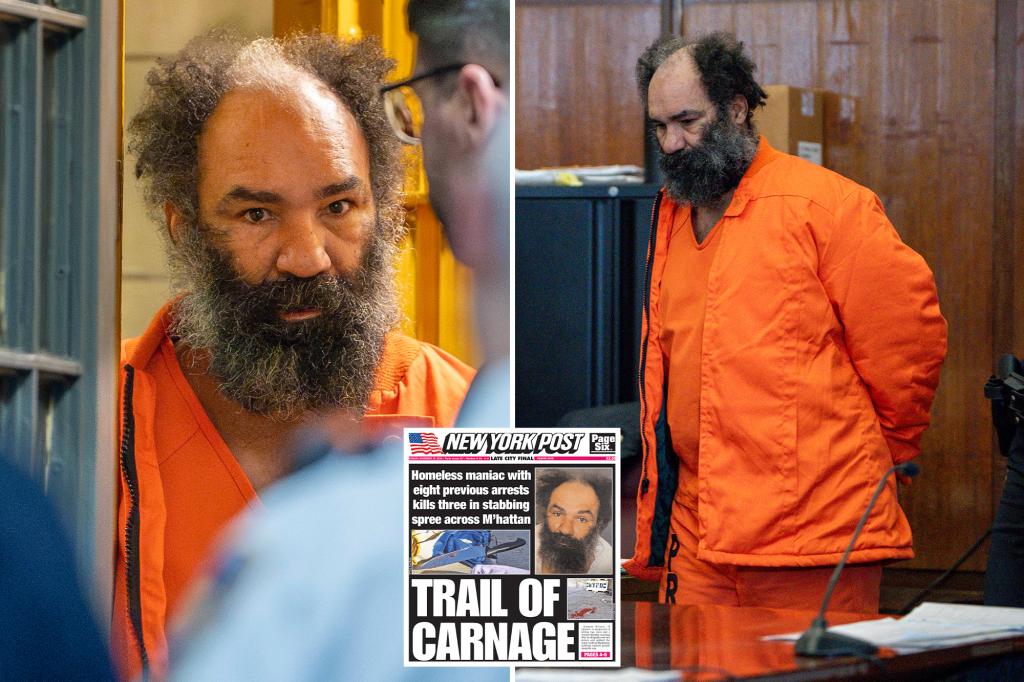On November 18th, a chilling series of events unfolded in Manhattan, leaving three individuals dead and the city reeling from the senseless violence. Ramon Rivera, 51, allegedly embarked on a premeditated stabbing spree, his actions meticulously outlined by prosecutors in subsequent court proceedings. Rivera’s rampage began with the calculated theft of kitchen knives and construction gloves from an Ace Hardware store near StuyTown. He shattered a window, grabbed the tools of his impending violence, and disappeared into the city streets. This act of preparation underscores the chilling premeditation of his subsequent attacks. Just three hours later, the first victim, 35-year-old Angel Lata Landi, was selected at random and fatally stabbed on West 19th Street. This unprovoked attack signaled the beginning of a reign of terror that would grip the city for the next few hours.
Rivera’s second target, 67-year-old Chang Wang, was enjoying a peaceful afternoon fishing on the FDR Promenade near East 30th Street. Unbeknownst to Wang, Rivera was stalking him, ultimately attacking him with the stolen knives. The vicious assault left Wang fatally wounded, another innocent life claimed in Rivera’s seemingly random spree of violence. Following the attack on Wang, Rivera continued his murderous path, encountering 36-year-old Wilna Augustin as she sat on a park bench. As Augustin screamed for help, Rivera allegedly attacked her, inflicting fatal injuries that would claim her life later in the hospital. This final act of brutality brought the total number of victims to three, marking the culmination of a terrifying series of events.
The seemingly random nature of Rivera’s attacks shocked and bewildered the city. Prosecutors emphasized the complete lack of provocation in each instance, highlighting the vulnerability of the victims who were simply going about their daily lives. The sheer randomness of the attacks heightened the sense of fear and unease that gripped the city in the aftermath. The attacks shattered the illusion of safety and served as a stark reminder of the fragility of life in an urban environment. The brutality of the crimes and the apparent lack of motive left many questioning the underlying causes of such senseless violence.
Following the attack on Augustin, Rivera’s reign of terror came to an abrupt end. Law enforcement apprehended him shortly after the final stabbing, bringing a sense of relief to the city. During his subsequent interrogation, Rivera confessed to the stabbings and the killing of the three victims, providing a chillingly detailed account of his actions. The confession offered a glimpse into the mind of the accused, shedding light on the premeditated nature of the attacks and the apparent lack of remorse. This confession became a key piece of evidence in the prosecution’s case against Rivera.
Rivera’s arraignment in Manhattan Supreme Court painted a clearer picture of his troubled past and mental health struggles. He pleaded not guilty to the charges of first-degree murder and three counts of second-degree murder. His attorney filed an insanity defense, citing Rivera’s history of mental illness. This defense strategy brought the focus onto Rivera’s mental state at the time of the crimes and raised questions about his culpability. The court heard details of Rivera’s previous encounters with law enforcement, including recent releases from Rikers Island for burglary and assault convictions, and a history of mental health incidents. His extensive out-of-state contacts, including arrests in Ohio and Florida, further complicated the case. This information painted a picture of a troubled individual with a long history of criminal activity and mental health issues.
Rivera’s violent past and documented mental health struggles provided a context for the tragic events of November 18th. His prior arrests spanned a range of offenses, including assault, domestic violence, and procuring prostitutes. His time spent in Bellevue Hospital’s psychiatric ward and repeated interactions with police over mental health episodes further underscored the severity of his condition. These incidents raised questions about the adequacy of the mental health system and the potential for preventing such tragedies in the future. The case sparked renewed discussions about the intersection of mental illness and criminal justice, highlighting the need for improved access to mental healthcare and support services. The tragic events served as a stark reminder of the challenges faced by individuals struggling with mental illness and the potential consequences when these struggles go unaddressed.

